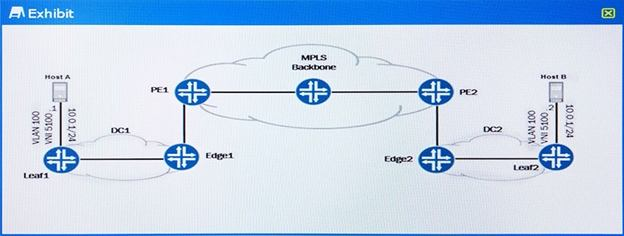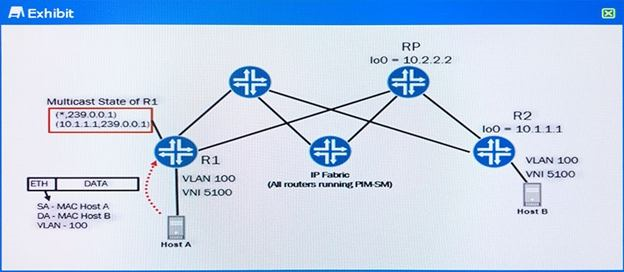File Info
| Exam | Data Center, Professional |
| Number | JN0-680 |
| File Name | Juniper.JN0-680.PracticeTest.2018-05-28.38q.vcex |
| Size | 3 MB |
| Posted | May 28, 2018 |
| Download | Juniper.JN0-680.PracticeTest.2018-05-28.38q.vcex |
How to open VCEX & EXAM Files?
Files with VCEX & EXAM extensions can be opened by ProfExam Simulator.
Coupon: MASTEREXAM
With discount: 20%





Demo Questions
Question 1
Your server administrator asks you to preserve the inner VLAN tags of the frames coming from a Layer 2 VXLAN Gateway of the EVPN-enabled segment.
Which two parameters must you add to the configuration to allow the VLAN tag to be passed? (Choose two.)
- layer2-protocol-tunneling
- decapsulate-accept-inner-vlan
- dotlq-tunneling
- encapsulate-inner-vlan
Correct answer: BD
Explanation:
Reference: https://www.juniper.net/documentation/en_US/junos/topics/reference/configuration-statement/encapsulate-inner-vlan.htmlReference: https://www.juniper.net/documentation/en_US/junos/topics/reference/configuration-statement/decapsulate-accept-inner-vlan.html Reference: https://www.juniper.net/documentation/en_US/junos/topics/reference/configuration-statement/encapsulate-inner-vlan.html
Reference: https://www.juniper.net/documentation/en_US/junos/topics/reference/configuration-statement/decapsulate-accept-inner-vlan.html
Question 2
Which two statements are correct when performing a unified ISSU? (Choose two.)
- The master Routing Engine and backup Routing Engine must be running the same software version before you can perform a unified ISSU.
- Unicast RPF-related statistics are not saved across a unified ISSU, and the unicast RPF counters are reset to zero during a unified ISSU.
- Unicast RPF-related statistics are saved across a unified ISSU, and the unicast RPF counters are not reset to zero during a unified ISSU.
- The backup Routing Engine must be running the most recent software version before you can perform a unified ISSU.
Correct answer: AB
Explanation:
Reference: https://www.juniper.net/documentation/en_US/junos/topics/reference/requirements/issu-system-requirements.html Reference: https://www.juniper.net/documentation/en_US/junos/topics/reference/requirements/issu-system-requirements.html
Question 3


Referring to the exhibit, PE1 and PE2 are acting as MPLS Layer 3 VPN PEs to provide the DCI between DC1 and DC2, which are IP Fabrics. Leaf 1 and Leaf 2 are QFX5100 Series devices acting as VXLAN Layer 2 Gateways using EVPN signaling for the same VXLAN segment.
Which statement is correct about the Edge1 device in this scenario?
- Edge1 must be configured for MP-BGP using EVPN signaling.
- Edge1 must be configured for MP-BGP using L3VPN signaling.
- Edge1 must be configured for BGP labeled unicast on its PE1-facing interface.
- Edge1’s routing table must contain an IP route to both Leaf1 and Leaf2.
Correct answer: A
Explanation:
Assumption here that the MPLS backbone network offers EVPN; this is the most fully-featured solution. This could also be achieved via C; BGP-LU shared with the provider, basically extending MPLS down to the Edge1+2 routers; this is less ‘risky’ for the MPLS backbone operator. B and D are ignoring EVPN/VXLAN components and refer to traditional Layer 3 IP routing. Reference: https://www.juniper.net/documentation/en_US/junos/topics/concept/evpns-overview.html Assumption here that the MPLS backbone network offers EVPN; this is the most fully-featured solution. This could also be achieved via C; BGP-LU shared with the provider, basically extending MPLS down to the Edge1+2 routers; this is less ‘risky’ for the MPLS backbone operator. B and D are ignoring EVPN/VXLAN components and refer to traditional Layer 3 IP routing.
Reference: https://www.juniper.net/documentation/en_US/junos/topics/concept/evpns-overview.html
Question 4


You are deploying a VXLAN using EVPN signaling overlay network. PE1 and PE2 are multihomed to the connected CE device. You notice that the traffic is not load-balancing as expected.
Referring to the exhibit, which two actions will solve this problem? (Choose two.)
- Set the route distinguisher on PE2 to 11.11.11.11:100.
- Set the LACP system ID on PE2 to 00:00:00:00:00:01.
- Set the ESI on both devices to 00:00:00:00:00:00:00:00:00:00.
- Set the ESI on PE2 to 00:11:11:11:11:11:11:11:11:11.
Correct answer: BD
Explanation:
Reference: https://www.juniper.net/documentation/en_US/junos/topics/concept/evpn-bgp-multihoming-overview.html Reference: https://tgregory.org/2016/06/21/evpn-all-active-multihoming/ Reference: https://www.juniper.net/documentation/en_US/junos/topics/concept/evpn-bgp-multihoming-overview.html
Reference: https://tgregory.org/2016/06/21/evpn-all-active-multihoming/
Question 5
In a preprovisioned mixed Virtual Chassis, which statement is correct about converting a 40Gbps QSFP+ to a Virtual Chassis port in an EX4300?
- LLDP is enabled on that interface.
- LLDP is disabled on that interface.
- One end of the link is configured as a Virtual Chassis port.
- Both ends of the link have the default configuration.
Correct answer: D
Explanation:
Reference: https://www.juniper.net/documentation/en_US/junos/topics/task/configuration/virtual-chassis-qfx-series-cli.html Reference: https://www.juniper.net/documentation/en_US/junos/topics/task/configuration/virtual-chassis-qfx-series-cli.html
Question 6
You are implementing a Virtual Chassis using QFX5100s and EX4300s in your data center.
In this scenario, which three hardware capabilities are affected? (Choose three.)
- usable VCP connections limited to 10GbE
- MAC table size
- number of usable ports per member
- number of supported routing instances
- maximum number of firewall filters
Correct answer: BDE
Explanation:
Reference: http://africa.westcon.com/documents/54080/ex-series-qfx-series-switching-product-comparison-matrix.pdf Reference: http://africa.westcon.com/documents/54080/ex-series-qfx-series-switching-product-comparison-matrix.pdf
Question 7
You are developing an EVPN service between your data centers to enable Layer 2 stretch and Virtual Machine Traffic Optimization (VMTO) operations.
In this scenario, which action must be performed on the IRB interface to accomplish this task?
- Configure the same IP address and let the MAC address be dynamically assigned on each PE.
- Configure the same IP address and the same MAC address on each PE.
- Configure different IP addresses but the same MAC address on each PE.
- Configure different IP addresses and different MAC addresses on each PE.
Correct answer: B
Explanation:
Reference: https://www.juniper.net/documentation/en_US/release-independent/solutions/information-products/pathway-pages/solutions/l3gw-vmto-evpn-vxlan-mpls.pdf Reference: https://www.juniper.net/documentation/en_US/release-independent/solutions/information-products/pathway-pages/solutions/l3gw-vmto-evpn-vxlan-mpls.pdf
Question 8
What are two methods used to scale an IBGP IP Fabric? (Choose two.)
- spanning tree
- redundant trunk groups
- route reflection
- confederations
Correct answer: CD
Question 9
You are building a mixed-mode Virtual Chassis with two QFX5100-24Qs, four QFX3500-48s, two EX4600-40Fs and two EX4300-48Ts. The Virtual Chassis will not provision.
In this scenario, which statement is correct?
- QFX3500s are not allowed in mixed mode.
- EX4600s are only allowed with EX4300s.
- EX4600s must be preprovisioned as the master and backup.
- Mixed-mode Virtual Chassis only allows for eight members.
Correct answer: B
Explanation:
Reference: https://www.juniper.net/documentation/en_US/junos/topics/concept/virtual-chassis-ex-qfx-series-mixed-understanding.html#jd0e133 Reference: https://www.juniper.net/documentation/en_US/junos/topics/concept/virtual-chassis-ex-qfx-series-mixed-understanding.html#jd0e133
Question 10


Referring to the exhibit, R1 and R2 are QFX5100 Series devices acting as VXLAN Layer 2 Gateways using PIM-SM signaling for the same VXLAN segment (VNI 5100). The multicast group assigned to VNI 5100 is 239.0.0.1. R1 currently has an entry in its MAC table for Host B.
In this scenario, how will R1 react to receiving the Ethernet frame from Host A?
- R1 will send a VXLAN encapsulated Ethernet frame using 10.1.1.1 as the destination address.
- R1 will send a VXLAN encapsulated Ethernet frame along the source-based multicast tree using 239.0.0.1 as the destination address.
- R1 will send a VXLAN encapsulated Ethernet frame using 10.2.2.2 as the destination address.
- R1 will send a VXLAN encapsulated Ethernet frame along the RP-based multicast tree using 239.0.0.1 as the destination address.
Correct answer: A
Explanation:
Host A and B are on the same subnet, so communicating at Layer 2 – MAC to MAC. The Layer 3 information is for VXLAN mapping to multicast groups – so the destination address is 239.0.0.1 group, and the tree is source-based (R1 has (10.1.1.1,239.0.0.1) in its multicast table). Assumption here the question infers Host A is sending a frame to Host B. Question poorly worded. Host A and B are on the same subnet, so communicating at Layer 2 – MAC to MAC. The Layer 3 information is for VXLAN mapping to multicast groups – so the destination address is 239.0.0.1 group, and the tree is source-based (R1 has (10.1.1.1,239.0.0.1) in its multicast table). Assumption here the question infers Host A is sending a frame to Host B. Question poorly worded.

